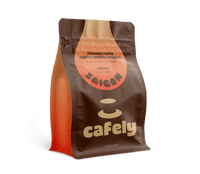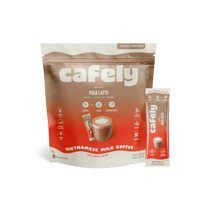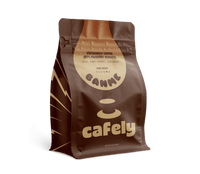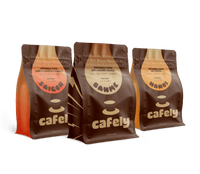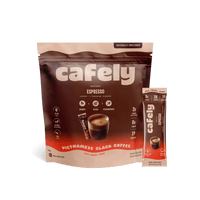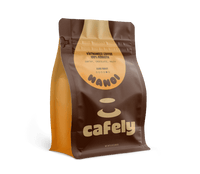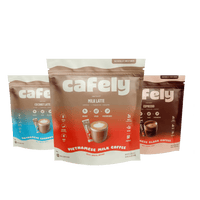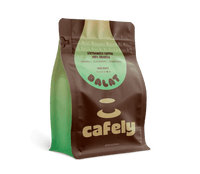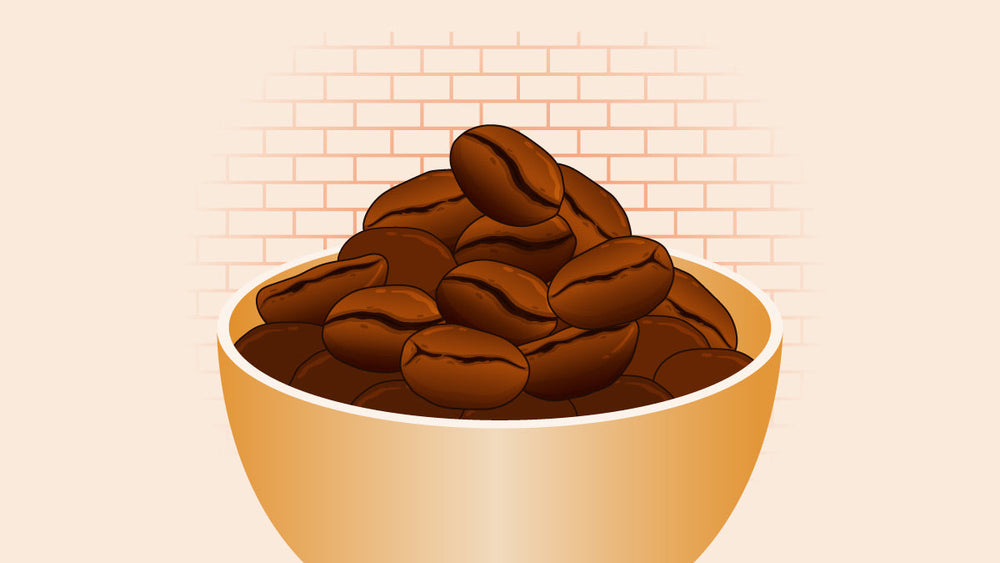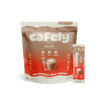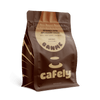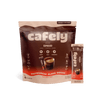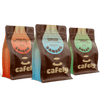Looking for a great entry-level coffee roast that’s smooth and bold? Medium roast coffee is immensely popular. It strikes a great middle-ground for many people — it’s neither as bitter as a dark roast nor as acidic as a light roast.
Let’s do a deep dive into medium roast coffee, talking about the science of roasting and the best ways to brew your medium roast roast beans.
How to Choose the Best Brand For Medium Roast Coffee
The flavor of the coffee is determined by several key factors, including growing practices, and the country of origin. Let’s review some key factors and talk about how they apply to medium-roast coffee.
- Organically Grown — Organic growing practices are ideal for reducing the environmental impact of your cup of coffee, and they can also encourage the natural growth of stronger plants. These stronger plants often produce higher-quality fruits, leading to a delicious final product.
- Certified Mold-Free — Mold can leave mycotoxins in contaminated coffee. Look for certified mold-free products and brands that are committed to regularly testing for mycotoxins.
- Sugar-Free — Added sugar can sometimes be used to mask certain flavors in coffee. For a more authentic coffee flavor that’s still sweet, look for coffee products that are naturally sweetened. This can give you the same sweetness while also providing health benefits that sugar doesn’t.
- Freshly Roasted — Coffee will start to lose flavor as soon as it’s finished roasting. Generally, coffee is in the perfect flavor window for around two months after roasting, beyond which it can become stale and flat. Always opt for freshly roasted coffee wherever you can to get the best flavors.
- Freshly Ground — Grinding coffee increases the speed at which it goes stale. Therefore, if you aim to get the most intense flavor possible out of your coffee, it’s best to buy beans and grind them immediately before brewing.
- Country of Origin — The specific country that any given coffee comes from can bring a number of unique notes to the flavor. We're partial to the huge variety that Vietnamese coffee offers, including the nutty and sweet notes of a good medium roast.
Our Best Medium Roasts
A medium roast is a great entry point into the world of specialty coffee. Here are our favorite choices to experience the complexity of a skillfully made medium roast:
1. DaNang Coffee

This is a beautiful medium roast Vietnamese coffee that blends arabica and robusta beans to create a rich and sumptuous flavor. In making this blend, our team honed in on both traditional and modern Vietnamese coffee culture. The result is a brew with a strong robusta base and delicate, bright arabica notes on top.
2. Vietnamese Harmony Coffee Trio
 With three different roasts, you’ll understand the complexity of the flavor notes within our coffee. Taking a little time to make three cups of coffee and sample them to experience the minute differences is sure to help you see the universe of coffee more completely.
With three different roasts, you’ll understand the complexity of the flavor notes within our coffee. Taking a little time to make three cups of coffee and sample them to experience the minute differences is sure to help you see the universe of coffee more completely.
What Is a Medium Roast?

Roasters define coffee levels mainly by the “crack” stages. When they roast coffee beans, the water inside them starts to boil and becomes steam. This steam needs to escape through the solid bean, creating tension and force. As the steam bursts out of the bean, roasters listen for a cracking noise.
This crack happens twice within the roasting process, with the first occurring at 385°F (196°C), and the second at 438°F to 450°F (225°C–232°C). These two cracks provide milestones for determining the roast level.
To understand this in more detail, take a look at the chart below showing the temperature of coffee beans relative to their roast level. Known as the “city scale.” This chart helps small roasters and vendors define their coffee roast levels.
|
Relative Roast Level |
City Level |
Crack Stage |
Tasting Notes |
Internal Bean Temperature |
|
Light |
City - |
Mid First |
Origin/plant focused — little “roasted” flavor. |
418°F (214°C) |
|
Light-Medium |
City |
First |
Origin/plant focused — little “roasted” flavor. |
425°F (218°C) |
|
Medium |
City + |
Late First |
Plant-derived flavors are still there, with increased body/richness. |
432°F (222°C) |
|
Medium |
Full City |
Between the First and Second |
A balance between plant acidity and roast body. |
438°F (225°C) |
|
Medium-Dark |
Full City + |
Early Second |
Slightly more oily and less acidic than Full City, though very similar. |
442°F (227°C) |
|
Dark |
French |
End of Second |
No origin flavor, with an intense “roasted” flavor. It may feel slightly burned and have little acidity. |
448°F (231°C) |
As you can see, medium roast coffee sits in the middle ground between 425°F and 438°F, a little bit after the first crack but before the second.
At this stage, the beans retain their natural acidity and flavors but become slightly sweeter. The longer the bean roasts, the more these flavors become and the more the natural sugars develop. Medium roast beans have a robust, rich body that's very easy to drink.
Why Choose a Medium Roast?
A roaster may choose a medium roast level mainly because it’s a popular choice for consumers. By finding a middle ground between the intensity of a dark roast and the brightness of a light roast, a roaster can produce a balanced, versatile bean that can be brewed using various methods.
There’s another reason for a medium roast, but it’s the same reason why more people sell light roasts nowadays. With better technology and growing methods, farmers produce higher-quality coffee than ever.
Most coffee beans taste better than they used to. Where a roaster may have roasted a bean for longer to mask some unpleasant flavors, the beans now taste better overall. Roasters can use a medium roast level to highlight the bean's more subtle characteristics.
What’s The Best Way To Brew Medium Roast Coffee?
In truth, medium roasts are a good choice for almost any brewing method because they strike a great balance between the brightness of a light roast coffee and the intensity of a dark one.
However, you must grind the bean to match your extraction method. For instance, espresso machines demand a fine grind because the water is only in contact with the coffee for around thirty seconds. Finely grinding your coffee increases its surface area, ensuring even extraction in a short period.
Here are a few different brewing options for medium-roast coffee that can bring amazing flavor to your taste buds.
1. French Press
Brewing medium-roast coffee with a French press is a great way to get a smooth, rounded flavor. Immersion brewing methods work by submerging grounds in hot water. By controlling the temperature and volume of water, you can carefully manage the exact flavors in your final cup.
For the best results, we suggest brewing medium roast coffee at a medium-coarse grind, around 90 to 95˚C (195-200˚F). Dose approximately 60 grams of coffee per liter of water and brew for around four minutes.
2. Pour-Over
Despite its reputation, pour-over brewing can be easy and delicious, too. To ensure the best flavor, grind your beans a little more finely than you may with a French Press for more saturation during the shorter contact time.
Using 60 grams of coffee per liter and a brewing water temperature of around 90˚C (195˚F), evenly saturate the coffee bed while regularly pouring water over the edges of the filter to ensure no coffee gets stuck on the sides.
3. Espresso
Brewing espresso with a medium roast coffee can result in some amazingly sweet and nutty flavors.
To get the best results, finely grind around 16 grams of coffee to the consistency of granulated sugar and fill the portafilter. Then, place the portafilter into the group head of your machine and start the brewing cycle. A single shot of espresso should produce around 2 oz (60 mL) of coffee in around 30 seconds.
4. Aeropress
For a strong cup of coffee, use the inverted Aeropress brewing method, pulling the stopper to the “4” mark and standing the Aeropress up on your countertop.
Add around 15 grams of coffee along with around 7 oz (200 mL) of hot water before stirring thoroughly and sealing with the filter paper and cap. Place your mug on top, and flip the assembly so that your mug is on the counter with the brewer on top.
Press down on the plunger slowly — the process should take around a minute and a half. Finally, remove the brewer and enjoy, topping up the cup with fresh hot water to around 10 oz (300 mL).
FAQs: Medium Roast Coffee

Do you still have questions about medium-roast coffee?
Check out the answers to the frequently asked questions below…
1. What’s the Best Way to Find out About Medium Roast Coffee?
Learning about medium roast coffee can be complex because each medium roast can vary both in bean type and flavor. A great way to take your time and interpret each flavor well is to do a “cupping” with your medium roast beans — brewing small amounts of black coffee to try.
2. Where Does a Medium Roast Fall on the City Scale?
While the City scale isn’t a precise measurement tool, it’s very popular. Generally, a medium roast will fall around “City +” or “Full City” on the scale. However, different roasters have different standards for their batches, so they may label a coffee as being medium when it’s only a City - on the scale.
3. What’s the Best Way to Brew Medium Roast Coffee?
Medium roast coffee is very forgiving, both in terms of flavor and grind. Therefore, it can be brewed using almost any method. To get the best out of the beans it’s important to make sure that the grind matches the brewing method. For example, use a fine grind for espresso, and a coarse grind for French press.
4. What Does a Medium Roast Coffee Taste Like?
A medium roast coffee strikes a healthy balance between the naturally present flavors of raw beans and the “roasted” flavors generated during processing. Therefore, it will tend to have bright, fruity notes as well as darker, full-bodied flavors.
5. What Beans Are Best for a Medium Roast?
Arabica beans are generally considered best for a medium roast. They naturally have more fat and sugar than other varieties, so their native plant flavors are smoother and more enjoyable.
6. Does Caffeine Content Change With Different Roast Levels?
Technically, the caffeine content doesn’t change with different roast levels. However, during the roast, water evaporates and is lost, making the beans less dense. This means that while lighter-weighing (dark roast) beans technically have a little less caffeine (per gram) than light roast beans, all beans have the same amount of caffeine per gram.
